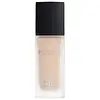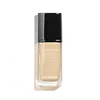Dior Forever Matte Foundation SPF 15 Versus Chanel Vitalumière Radiant Moisture-Rich Fluid Foundation
What's inside
What's inside
 Key Ingredients
Key Ingredients

 Benefits
Benefits

 Concerns
Concerns

 Ingredients Side-by-side
Ingredients Side-by-side

Ethylhexyl Salicylate 3.5%
UV AbsorberTitanium Dioxide 0.94%
Cosmetic ColorantWater
Skin ConditioningMethyl Trimethicone
Skin ConditioningIsododecane
EmollientAlcohol
AntimicrobialSynthetic Fluorphlogopite
Butylene Glycol
HumectantPEG-9 Polydimethylsiloxyethyl Dimethicone
EmulsifyingAcrylates/Polytrimethylsiloxymethacrylate Copolymer
Skin ConditioningSilica
AbrasiveDimethicone
EmollientAcrylates/Dimethicone Copolymer
Skin ConditioningDisteardimonium Hectorite
StabilisingCetyl Dimethicone
EmollientPolyglyceryl-10 Decaisostearate
EmollientSodium Myristoyl Glutamate
CleansingParfum
MaskingPropylene Carbonate
SolventChlorphenesin
AntimicrobialAluminum Hydroxide
EmollientTromethamine
BufferingHydrolyzed Viola Tricolor Extract
Skin ProtectingTocopherol
AntioxidantAlumina
AbrasiveStearic Acid
CleansingTropaeolum Majus Flower/Leaf/Stem Extract
Skin ConditioningRosa Multiflora Fruit Extract
Masking1,2-Hexanediol
Skin ConditioningCaprylyl Glycol
EmollientIris Florentina Root Extract
MaskingSodium Benzoate
MaskingPotassium Sorbate
PreservativeCI 77491
Cosmetic ColorantCI 77492
Cosmetic ColorantCI 77499
Cosmetic ColorantCI 77891
Cosmetic ColorantEthylhexyl Salicylate 3.5%, Titanium Dioxide 0.94%, Water, Methyl Trimethicone, Isododecane, Alcohol, Synthetic Fluorphlogopite, Butylene Glycol, PEG-9 Polydimethylsiloxyethyl Dimethicone, Acrylates/Polytrimethylsiloxymethacrylate Copolymer, Silica, Dimethicone, Acrylates/Dimethicone Copolymer, Disteardimonium Hectorite, Cetyl Dimethicone, Polyglyceryl-10 Decaisostearate, Sodium Myristoyl Glutamate, Parfum, Propylene Carbonate, Chlorphenesin, Aluminum Hydroxide, Tromethamine, Hydrolyzed Viola Tricolor Extract, Tocopherol, Alumina, Stearic Acid, Tropaeolum Majus Flower/Leaf/Stem Extract, Rosa Multiflora Fruit Extract, 1,2-Hexanediol, Caprylyl Glycol, Iris Florentina Root Extract, Sodium Benzoate, Potassium Sorbate, CI 77491, CI 77492, CI 77499, CI 77891
Water
Skin ConditioningCaprylic/Capric Triglyceride
MaskingGlycerin
HumectantEthylhexyl Palmitate
EmollientRicinus Communis Seed Oil
MaskingUndecane
EmollientPolyglyceryl-3 PCA
EmollientPolyglyceryl-6 Polyhydroxystearate
EmulsifyingSynthetic Fluorphlogopite
Propylene Glycol
HumectantSilica
AbrasivePolyglyceryl-6 Polyricinoleate
EmulsifyingTridecane
PerfumingMagnesium Sulfate
Sodium Chloride
MaskingTerminalia Ferdinandiana Fruit Extract
AntioxidantGlycyrrhiza Glabra Root Extract
BleachingButylene Glycol
HumectantStearalkonium Hectorite
Gel FormingTocopheryl Acetate
AntioxidantParfum
MaskingPotassium Sorbate
PreservativeDisodium Stearoyl Glutamate
CleansingCaprylyl Glycol
EmollientPropylene Carbonate
SolventPentylene Glycol
Skin ConditioningLauroyl Lysine
Skin ConditioningSodium Hyaluronate
HumectantAluminum Hydroxide
EmollientLaminaria Digitata Extract
Skin ProtectingTocopherol
AntioxidantAscorbyl Palmitate
AntioxidantHelianthus Annuus Seed Oil
EmollientCI 77007
Cosmetic ColorantCI 77491
Cosmetic ColorantCI 77492
Cosmetic ColorantCI 77499
Cosmetic ColorantCI 77891
Cosmetic ColorantMica
Cosmetic ColorantWater, Caprylic/Capric Triglyceride, Glycerin, Ethylhexyl Palmitate, Ricinus Communis Seed Oil, Undecane, Polyglyceryl-3 PCA, Polyglyceryl-6 Polyhydroxystearate, Synthetic Fluorphlogopite, Propylene Glycol, Silica, Polyglyceryl-6 Polyricinoleate, Tridecane, Magnesium Sulfate, Sodium Chloride, Terminalia Ferdinandiana Fruit Extract, Glycyrrhiza Glabra Root Extract, Butylene Glycol, Stearalkonium Hectorite, Tocopheryl Acetate, Parfum, Potassium Sorbate, Disodium Stearoyl Glutamate, Caprylyl Glycol, Propylene Carbonate, Pentylene Glycol, Lauroyl Lysine, Sodium Hyaluronate, Aluminum Hydroxide, Laminaria Digitata Extract, Tocopherol, Ascorbyl Palmitate, Helianthus Annuus Seed Oil, CI 77007, CI 77491, CI 77492, CI 77499, CI 77891, Mica
 Reviews
Reviews

Ingredients Explained
These ingredients are found in both products.
Ingredients higher up in an ingredient list are typically present in a larger amount.
Aluminum Hydroxide is a form of aluminum. It can be naturally found in nature as the mineral gibbsite. In cosmetics, Aluminum Hydroxide is used as a colorant, pH adjuster, and absorbent.
As a colorant, Aluminum Hydroxide may add opacity, or reduce the transparency. Aluminum hydroxide is contains both basic and acidic properties.
According to manufacturers, this ingredient is an emollient and humectant. This means it helps hydrate the skin.
In medicine, this ingredient is used to help relieve heartburn and help heal ulcers.
There is currently no credible scientific evidence linking aluminum hydroxide in cosmetics to increased cancer risk.
Major health organizations allow the use of aluminum hydroxide in personal care products and have not flagged it as a carcinogenic risk at typical usage levels.
Learn more about Aluminum HydroxideButylene Glycol (or BG) is used within cosmetic products for a few different reasons:
Overall, Butylene Glycol is a safe and well-rounded ingredient that works well with other ingredients.
Though this ingredient works well with most skin types, some people with sensitive skin may experience a reaction such as allergic rashes, closed comedones, or itchiness.
Learn more about Butylene GlycolCaprylyl Glycol is a humectant and emollient, meaning it attracts and preserves moisture.
It is a common ingredient in many products, especially those designed to hydrate skin. The primary benefits are retaining moisture, skin softening, and promoting a healthy skin barrier.
Though Caprylyl Glycol is an alcohol derived from fatty acids, it is not the kind that can dry out skin.
This ingredient is also used as a preservative to extend the life of products. It has slight antimicrobial properties.
Learn more about Caprylyl GlycolCi 77491 is also hydrated iron III oxide. It's sole purpose is to give a red/pink hue to products.
Iron III oxides are classified as inorganic chemicals for coloring.
Synthetically created Ci 77491 is considered safer than those naturally found. This is because the synthetically created version may contain less impurities. Iron oxides are generally non-toxic and non-allergenic.
Learn more about CI 77491Ci 77492 is also hydrated iron III oxide. It's sole purpose is to give a yellow hue to products.
Iron III oxides are classified as inorganic chemicals for coloring.
Synthetically created Ci 77492 is considered safer than those naturally found. This is because the synthetically created version may contain less impurities. Iron oxides are generally non-toxic and non-allergenic.
Learn more about CI 77492Ci 77499 is also hydrated iron III oxide. It is created from mixing red and black iron oxides. This helps give shades of darkness to a product.
Iron III oxides are classified as inorganic chemicals for coloring.
Ci 77891 is a white pigment from Titanium dioxide. It is naturally found in minerals such as rutile and ilmenite.
It's main function is to add a white color to cosmetics. It can also be mixed with other colors to create different shades.
Ci 77891 is commonly found in sunscreens due to its ability to block UV rays.
Learn more about CI 77891Parfum is a catch-all term for an ingredient or more that is used to give a scent to products.
Also called "fragrance", this ingredient can be a blend of hundreds of chemicals or plant oils. This means every product with "fragrance" or "parfum" in the ingredients list is a different mixture.
For instance, Habanolide is a proprietary trade name for a specific aroma chemical. When used as a fragrance ingredient in cosmetics, most aroma chemicals fall under the broad labeling category of “FRAGRANCE” or “PARFUM” according to EU and US regulations.
The term 'parfum' or 'fragrance' is not regulated in many countries. In many cases, it is up to the brand to define this term.
For instance, many brands choose to label themselves as "fragrance-free" because they are not using synthetic fragrances. However, their products may still contain ingredients such as essential oils that are considered a fragrance by INCI standards.
One example is Calendula flower extract. Calendula is an essential oil that still imparts a scent or 'fragrance'.
Depending on the blend, the ingredients in the mixture can cause allergies and sensitivities on the skin. Some ingredients that are known EU allergens include linalool and citronellol.
Parfum can also be used to mask or cover an unpleasant scent.
The bottom line is: not all fragrances/parfum/ingredients are created equally. If you are worried about fragrances, we recommend taking a closer look at an ingredient. And of course, we always recommend speaking with a professional.
Learn more about ParfumPotassium Sorbate is a preservative used to prevent yeast and mold in products. It is commonly found in both cosmetic and food products.
This ingredient comes from potassium salt derived from sorbic acid. Sorbic acid is a natural antibiotic and effective against fungus.
Both potassium sorbate and sorbic acid can be found in baked goods, cheeses, dried meats, dried fruit, ice cream, pickles, wine, yogurt, and more.
You'll often find this ingredient used with other preservatives.
Learn more about Potassium SorbateThis ingredient is a solvent. It helps dissolve active ingredients and alter the texture of products.
Propylene Carbonate is commonly used in makeup and with clay, such as montmorillonite or bentonite.
Studies show this ingredient to be safe for cosmetics. When it is undiluted, it can cause skin irritation. (It is always diluted in skincare and makeup). This ingredient is water-soluble.
Propylene Carbonate is created from propylene glycol and carbonic acid.
Learn more about Propylene CarbonateSilica, also known as silicon dioxide, is a naturally occurring mineral. It is used as a fine, spherical, and porous powder in cosmetics.
Though it has exfoliant properties, the function of silica varies depending on the product.
The unique structure of silica enhances the spreadability and adds smoothness, making it a great texture enhancer.
It is also used as an active carrier, emulsifier, and mattifier due to its ability to absorb excess oil.
In some products, tiny microneedles called spicules are made from silica or hydrolyzed sponge. When you rub them in, they lightly polish away dead skin layers and enhance the penetration of active ingredients.
Learn more about SilicaSynthetic Fluorphlogopite is the synthethic version of mica. It consists of fluorine, aluminum and silicate.
Synthetic Fluorphlogopite is used to add volume to products.
It is considered non-irritating on the skin.
Learn more about Synthetic FluorphlogopiteTocopherol (also known as Vitamin E) is a common antioxidant used to help protect the skin from free-radicals and strengthen the skin barrier. It's also fat soluble - this means our skin is great at absorbing it.
Vitamin E also helps keep your natural skin lipids healthy. Your lipid skin barrier naturally consists of lipids, ceramides, and fatty acids. Vitamin E offers extra protection for your skin’s lipid barrier, keeping your skin healthy and nourished.
Another benefit is a bit of UV protection. Vitamin E helps reduce the damage caused by UVB rays. (It should not replace your sunscreen). Combining it with Vitamin C can decrease sunburned cells and hyperpigmentation after UV exposure.
You might have noticed Vitamin E + C often paired together. This is because it is great at stabilizing Vitamin C. Using the two together helps increase the effectiveness of both ingredients.
There are often claims that Vitamin E can reduce/prevent scarring, but these claims haven't been confirmed by scientific research.
Learn more about TocopherolWater. It's the most common cosmetic ingredient of all. You'll usually see it at the top of ingredient lists, meaning that it makes up the largest part of the product.
So why is it so popular? Water most often acts as a solvent - this means that it helps dissolve other ingredients into the formulation.
You'll also recognize water as that liquid we all need to stay alive. If you see this, drink a glass of water. Stay hydrated!
Learn more about Water